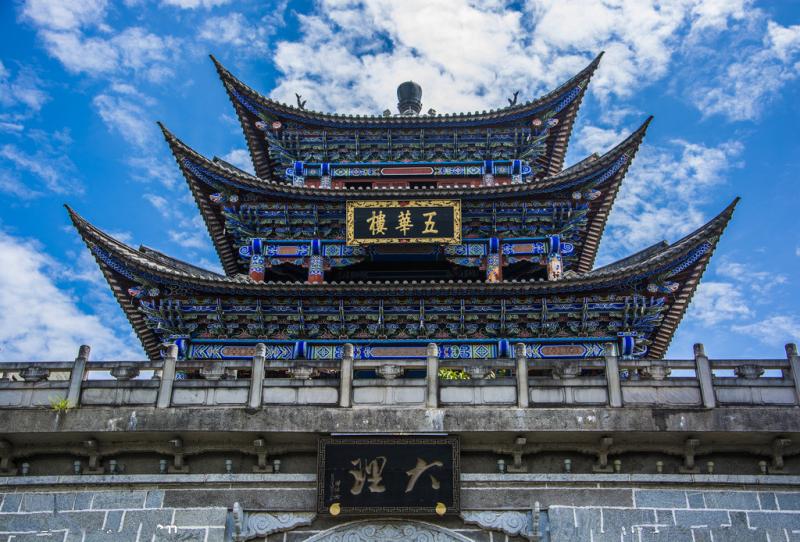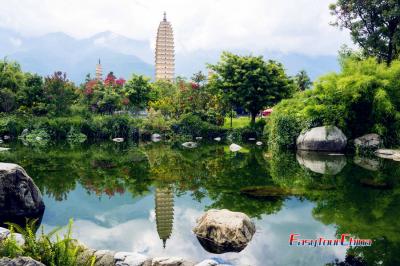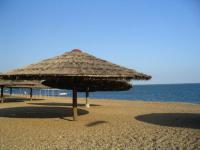Old Dali Town
Located between Erhai Lake and Cangshan Mountain, Dali old town is 13 km away from Xiaguan, the new urban area. Traveling in Dali, tourists can find the relaxing atmosphere and laid-back pace of life. Many international backpackers have regarded it as a Mecca to tune out for a while.
In History, Dali was also called Yeyu, and Purple City. The circumference of Dali Ancient City is 6 kilometers long. The city wall is 8 meters high and 7 meters thick. The interior of the wall was filled with rocks and the surface was bricked over smoothly. The four gate towers in the east, south, west and north are named Tong Hai, Chen En, Cang Shan and An Yuan respectively.
From 8th to 13th century, Dali Ancient City was the capital of Nanzhao and Dali Kingdoms and the political center of Yunnan and nearby area. The old city wall was first built in 1382 during the Ming Dynasty (1368-1644). In 1982, Dali was added in the top historical cities of China.
The ancient city of Dali is one of the most beautiful ancient towns in China and one of the top destinations in Yunnan. Walking in the cobbled streets of Dali, you will get a feel of relaxed atmosphere. Handicraft shops and restaurants are lined up along the way. Huguo Road is the main strip for cafes - locals call it 'Foreigner’s Street', where you can enjoy the western coffee, pizza, sandwich and other treats.

Dali Ancient Town Facts
Where Is It the Old Dali Town Located
Located in northwestern Yunnan Province, Dali Ancient City is at the southern end of the Hengduan Mountains, at the foot of Cangshan Mountain and on the shore of Erhai Lake. Its central location is at 25°41′26″ north latitude and 100°9′45″ east longitude.
Approximately 65 million years ago, the collision between the Indian and Eurasian tectonic plates caused the ancient Tethys Sea to uplift into land. During the Himalayan orogeny, the Cangshan Mountains fractured and rose, ultimately forming 19 peaks exceeding 3,000 meters in elevation. The Dali Basin, where the ancient city of Dali is located, is precisely the fault-block depression “squeezed” out during the uplift of Cangshan. At an elevation of 2,052 meters, it serves as a “buffer zone” where the foothills of Cangshan transition to Erhai Lake.
This location boasts inherent geographical advantages: streams from Cangshan form natural drainage channels along the basin's edge, preventing the ancient city from flooding; the 2,052-meter slopes maintain an average annual temperature of 15°C, creating a spring-like climate year-round; and its elevated, commanding position made the city easily defensible yet difficult to attack in ancient times.
With an elevation difference of only 80 meters between Erhai Lake and the ancient city at 2,052 meters, the town naturally benefits from the “lake breeze effect.” This moderates summer heat and reduces winter humidity, maintaining year-round humidity levels between 60% and 70% due to the lake's regulating influence.
Brief History of Old Dali Town
During the Tang and Song dynasties, Dali successively established two local regimes: the Nanzhao Kingdom and the Kingdom of Dali. In the 27th year of the Kaiyuan era of the Tang Dynasty (739 AD), Taihe City (present-day Taihe Street in Dali) was selected by the Nanzhao Kingdom as its capital. Taihe City was divided into an outer city and an inner city. The outer city featured two parallel walls running north-south. Their western ends connected atop Mount Jingang, with the southern wall stretching approximately 3,350 meters eastward and the northern wall measuring about 3,225 meters. Located at an altitude of only 1,900 meters near Erhai Lake, the site offered convenient transportation but faced frequent flood threats.
In the 8th century, King Yimouxun of Nanzhao relocated the capital to Yangzumei City (present-day core area of Dali Ancient City).

After the Yuan Dynasty conquered the Dali Kingdom, the ancient city's military role diminished while its cultural significance grew. Temples dedicated to the Bai people's ancestral deities were often built on the surrounding hills.
Historically, Dali Ancient City served as a crucial hub along the Tea Horse Road—connecting northward to Lijiang and Shangri-La, southward to Baoshan and Dehong, and eastward through Chuxiong into the heart of China.
>> Recommended 16 Days Yunnan Odyssey Tour along Ancient Tea-horse Road
What to See & Do: Top Dali Old Town Attractions
Ancient City Towers
Literature Tower
Constructed during the Kangxi reign of the Qing Dynasty, the Literature Tower derives its name from the plaque inscribed with “Land of Literary Excellence,” bestowed by Yunnan's military governor Piantu in the 40th year of Kangxi (1701). This two-story, hip-and-gable timber-and-stone structure embodies quintessential Bai ethnic architecture.
Wuhua Tower
Originally serving as the state guesthouse for the Nanzhao kings, Wuhua Tower witnessed the encampment of Kublai Khan's troops before his conquest of Dali. Destroyed by war during the early Ming Dynasty, it was rebuilt as the Bell and Drum Tower during the Hongwu era when the ancient city was reconstructed. It stands as the highest point within the old city walls.
South City Gate Tower
Also known as Shuanghe Tower or Cheng'en Tower, the South City Gate stands as the foremost of the ancient city's four gates. Constructed in the 15th year of the Hongwu era (1382), it is the oldest and most majestic structure within the walls, serving as a symbol and landmark of Dali Ancient City. The city walls measure approximately 1,500 meters in length on each side, standing 6 meters high and 12 meters thick.
North City Gate Tower
The North City Gate Tower, also known as “An Yuan Tower,” was first built in 1382 and is one of the four city gates. Its roof features the double-eave hip-and-gable style, a higher-grade design in Chinese palace architecture, preserving the architectural style of the Ming Dynasty.
Ancient Academies
Xiyun Academy
Located within Dali No. 1 Middle School, it is a quintessential example of Dali's ancient architecture. It holds significant value for researching Dali's educational history, late Qing Dynasty history, and ancient architectural gardens.
Dali Prefecture Examination Hall
The Dali Prefecture Examination Hall, situated on the east side of the northern section of Bo'ai Road in Dali Ancient City, served as the venue for the imperial examinations for students from northwest Yunnan during the Qing Dynasty.

Ancient Temples
Catholic Church
The Catholic Church in Dali Ancient City served as the central cathedral for the Western Yunnan Diocese. Constructed between 1927 and 1932 by Father Yan Meizhang (Chinese name), a priest of the Paris Foreign Missions Society, it features a wooden structure with eaves supported by brackets adorned with auspicious creatures like lions, elephants, dragons, and phoenixes. Oriented east to west, the complex comprises a main gate, passageway, secondary gate, and chapel. It features Bai ethnic solid-wood architecture with eaves supported by bracket sets adorned with auspicious beasts like lions, elephants, dragons and phoenixes.
Dali Three Pagodas
The Three Pagodas of Dali (also known as the Chongsheng Temple Three Pagodas) are among China's most famous Buddhist pagodas. The main pagoda, Qianxun Pagoda, is a square, 16-story, multi-eaved pagoda, 9.9 meters wide at the base and 69.13 meters high. It is topped with a bronze dome and a finial, and is a typical Tang Dynasty building, similar to the Big and Small Wild Goose Pagodas in Xi'an.
>> Recommended Dali Tours:
Main Streets
Fuxing Road
Fuxing Road is the main thoroughfare and most bustling street in Dali Old Town. Connecting the South and North Gates, Fuxing Road is 1500 meters long and paved with cobblestones. It is the longest north-south thoroughfare in the old town. The shops along Fuxing Road retain the architectural style of the Ming and Qing Dynasties, making it the main commercial street of Dali Old Town.
Foreigners' Street
Originally named “Huogu Road,” Foreigners' Street commemorates the Yunnan people's uprising against Yuan Shikai's imperial ambitions during the early Republic of China era. Running east-west, Huogu Road stretches 1,000 meters in length and 7 meters in width, paved with blue stone slabs. Its most vibrant section spans 185.6 meters in the middle, making it one of China's earliest and most renowned foreigner districts.
Museums
The Dali City Museum
The Dali City Museum houses nearly 10,000 precious cultural relics spanning from the Neolithic era to modern times in the Dali region. Its collection includes 17 first-class cultural relics (sets), 257 second-class cultural relics (sets), and 190 third-class cultural relics (sets). It opened permanently free to the public on May 18, 2009.
Dali Intangible Cultural Heritage Museum
Located at No. 123 Yu'er Road in Old Dali Town, it occupies the best-preserved Qing Dynasty ancestral hall complex within the ancient city walls, representing the pinnacle of Bai ethnic architectural art. The museum houses a collection of 535 intangible cultural heritage exhibits.

Folk Culture: Dali's “Rituals of Daily Life”
Must-eat Food in Dali Old Town

Dali Weather & Best Time to Visit
Dali Ancient City is located in the windward zone of the southwest monsoon belt of the Bay of Bengal, and belongs to the subtropical plateau monsoon climate type. It is characterized by moderate temperatures, mild climate, small annual temperature range, and large daily temperature range.
The dam area falls within the North Subtropical Plateau Monsoon Climate Zone, with an annual average temperature of 15.1°C. The hottest month averages 20.1°C, while the coldest month averages 8.7°C. The annual temperature variation averages 11.4°C, with daily variations ranging from 11.6°C to 13.1°C.
Generally, March to May and September to November are considered the best time to visit Dali Old Town.
>> Recommended Yunnan Tours with Dali Old Town


